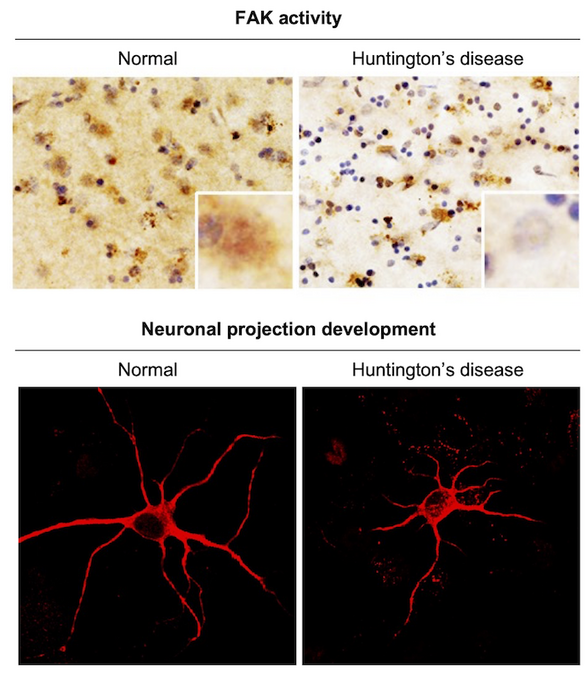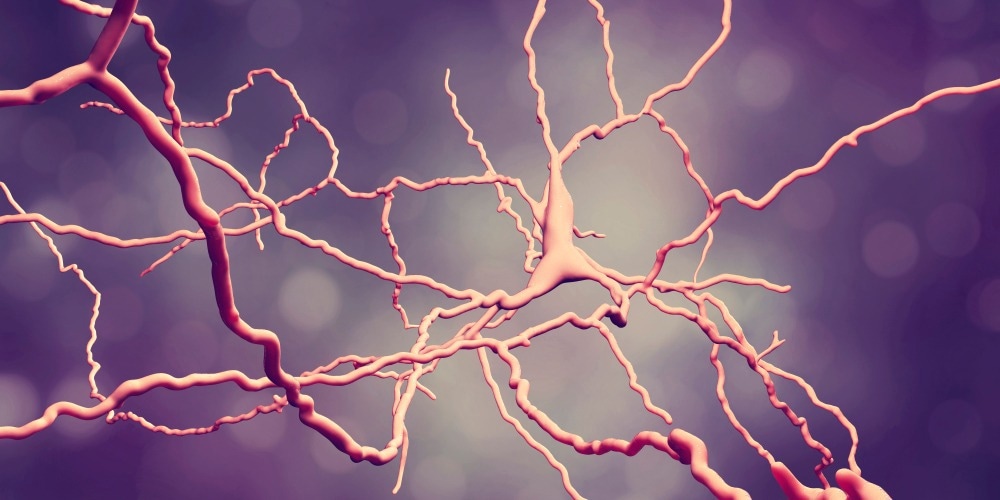Reviewed by Danielle Ellis, B.Sc.Sep 19 2022
Huntington’s disease (HD) is a hereditary disorder that results from a mutation in the huntingtin gene. HD is a neurodegenerative condition with no cure that includes personality changes, dementia symptoms, and uncontrollable convulsive movements after the disease’s inception at roughly 40 years of age, eventually leading to death.
 Differences in FAK activation and neuronal protrusion formation in brain tissues of normal and Huntington’s disease patients. Image Credit: Korea Institute of Science and Technology
Differences in FAK activation and neuronal protrusion formation in brain tissues of normal and Huntington’s disease patients. Image Credit: Korea Institute of Science and Technology
These HD symptoms are known to be produced by the loss of brain cells in the striatum as a result of difficulties emerging in synapses that are critical to brain function as the disease progresses. However, the precise mechanism underlying brain damage as HD progress remains unknown.
Dr. Jihye Seong and Dr. Hoon Ryu, principal researchers at the Brain Science Institute (BSI) of the Korea Institute of Science and Technology (KIST, President Seokjin Yoon), were said to have discovered substantially decreased activity of focal adhesion kinase (FAK) proteins that play a significant role in neurite motility and proper synapse formation in HD patients’ brain tissues.
Activated FAK proteins perform a major role in the function of the brain as they are vital in proper synapse formation and neurite motility. The KIST research team discovered a significant decrease in FAK activity in HD cells, mice models, and brain tissues from HD patients.

Image Credit: Kateryna Kon/Shutterstock.com
These findings were also supported by precise measurements of FAK activity in living cells using a biosensor based on fluorescence resonance energy transfer (FRET).
Phosphatidylinositol 4,5-biphosphate (PIP2), a phospholipid present in the cell membrane, is required for FAK protein activation.
Using super-resolution structured illumination microscopy, the scientists found that PIP2 was exceptionally firmly linked to the mutant huntingtin protein in HD cells, preventing correct PIP2 distribution across the cell membrane.
This aberrant PIP2 distribution suppresses FAK activation, preventing appropriate synaptic function and resulting in brain dysfunction in the early stages of HD.
The pathological mechanisms of synaptic dysfunction in patients with Huntington’s disease revealed through this study could be utilized as a therapeutic target for the treatment of brain dysfunction.”
Dr Jihye Seong, Principal Researcher, Brain Science Institute, Korea Institute of Science and Technology
Dr. Ryu adds, “Because the results of this study show the pathological mechanisms found in actual brain tissues of patients with HD, I believe it has a greater significance in suggesting a new therapeutic target for human degenerative brain diseases.”
Source:
Journal reference:
Lee, H. N., et al. (2022) Decreased FAK activity and focal adhesion dynamics impair proper neurite formation of medium spiny neurons in Huntington’s disease. Acta Neuropathologica. doi.org/10.1007/s00401-022-02462-z.